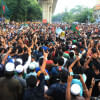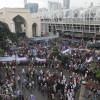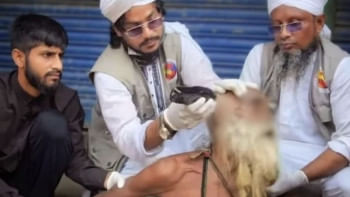Who will the citizens vote for in the next election?

Thanks to consecutive rigged elections after 2008, voters' preference structure has become almost like a black box to us. Now that the July uprising has created an opportunity to restore the democratic system in Bangladesh, surveys are being conducted to understand the evolving voters' preferences. Recently, Innovision, a research and consulting organisation, conducted a survey on this. It released the results of the survey on March 8, focusing on capturing citizens' election-related perceptions through a set of sharp and well-designed questions. The survey covered a total sample of 10,696 respondents across eight divisions and 64 districts.
The most discussed aspect of the survey—circulating widely on social media and in mainstream media—was the findings of voting preferences. According to the survey results, of those who expressed a party preference in the upcoming election, 41.7 percent expressed support for Bangladesh Nationalist Party (BNP), 31.6 percent for Jamaat-e-Islami, 13.9 percent for Awami League (AL), and 5.1 percent for the youth-led political party. The remaining 7.6 percent opted for other parties. While some of the political parties and their supporters were excited about the result, some were quite upset about the findings and discarded them outright.
While the survey was accurate, the presentation of the statistics was not. This particular question, "Whom would you vote for if the election was held now?" was part of a broader set comprising three distinct questions. The first question—whether they decided whom to vote for—was asked to the entire sample of 10,696 households, among which 6,632 responded yes. The next question was asked to those 6,632 respondents. It was if they were willing to reveal their decisions, to which 4,356 agreed. The final question was asked only to these 4,356 respondents who had decided on their vote and agreed to disclose it. So, the percentage that is circulating in the public domain is not based on the entire sample; rather, it represents a fraction of the total sample. If we use a different representation of the data based on the full sample, then we would get a preference landscape, as shown in the figure. The figure indicates that out of the total sampled population, we only know the preferences of around 41 percent, and as of now, we don't know whom the remaining 59 percent will vote.
Based on the survey result, it gets difficult to predict the electoral outcome. However, we may get some idea if we analyse the background information available on these 59 percent voters. The survey shows that a higher percentage of urban, Gen Z (18-28 years), and female voters are mostly undecided, and there is a possibility that these groups will play an important role in determining the electoral outcome.
At the same time, it is important to note that the undecided voters (29.4 percent) are most likely to be swing voters (who could go either way) because their choices are not determined by rigid party loyalty. We have converted the multiple response question to a single response for simplifying. The responses of 40 percent indicate that they are likely to consider the qualifications of the candidates to determine their preferences, while 27 percent of them would make their decisions based on the political situation before the election. It is likely that among the undecided voters, there is a percentage of "shy" AL voters, especially the five percent who are concerned that their preferred party may not participate in the next election. About eight percent of the undecided voters mentioned that they are undecided because they don't trust any mainstream political parties, and three percent of them are not satisfied with the options available. Therefore, there is a possibility that this 11 percent (8+3) of the undecided voters may opt for a new political party if the party succeeds in playing its card right. This is not surprising because, over the years, different surveys have shown that people in Bangladesh are getting frustrated with the mainstream political parties and are looking for alternatives. For instance, in the TAF-BIGD surveys in 2018 and 2022, more than 60 percent of respondents said they would affiliate with a new party if its ideology matched theirs.
The survey also sheds light on how citizens make their voting decisions. Family voting history and community political norms appear to play a disproportionately significant role in shaping individual choices. When we categorise the responses to the question asking participants to identify the three most influential factors in their electoral decisions, two broad groups emerge. Again, we convert the multiple-response question to single responses for simplicity.
The first group encompasses personal and community influences, including family members (28.6 percent), neighbours (12.1 percent), friends (5.5 percent), colleagues (2.1 percent), and religious and community leaders (2.4 percent). The second group consists of influence by various media sources such as social media news (11.1 percent), television news (9.2 percent), social media content (three percent), newspapers (2.6 percent), and talk shows (1.3 percent). Combining the responses of the first group, it appears that the majority (51 percent) of responses pointed to the influence of family, friends, and community, while only about 27 percent indicated that media sources played a role in shaping voting decisions.
The first of the key trends that we can observe from the most recent survey is that the old and predictable electoral scenario of AL and BNP's duopolistic and hegemonic control over voters' choices seem to be eroding. Second, such breakdown of the duopolistic control can be, perhaps, attributed to the rise of Jamaat and the resurfacing of smaller religion-based groups, and the entry of a new challenger—the youth-led political party. However, such emerging voters' choice structure is in a fluid state, and we will have to wait for a few months to see what shape it takes. Third, the formation of voters' preferences seems to be predominantly influenced by family traditions, community norms, as well as history of voting. Such primordial, collective, and sticky norms seem to be casting a long shadow over current voters' preferences, and this will, perhaps, hugely benefit BNP and, to a limited extent, Jamaat. The youth-led new party—NCP—will need to embark on a Herculean task to deal with this.
Dr Mirza Hassan is senior research fellow at Brac Institute of Governance and Development (BIGD).
Syeda Salina Aziz is fellow of practice in the politics and governance cluster at BIGD.
Dr Asif Shahan is professor at Dhaka University and visiting research fellow at BIGD.
Views expressed in this article are the author's own.
Follow The Daily Star Opinion on Facebook for the latest opinions, commentaries and analyses by experts and professionals. To contribute your article or letter to The Daily Star Opinion, see our guidelines for submission.

 For all latest news, follow The Daily Star's Google News channel.
For all latest news, follow The Daily Star's Google News channel. 








Comments